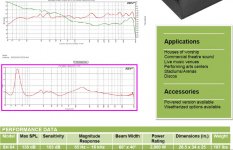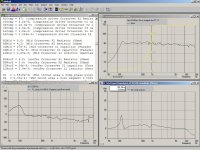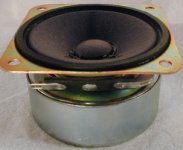True. One of the things that can be tough is keeping the impedance of a Unity/Synergy up above 4 ohms. If you look at the Danley site, you'll see most of the Synergy horns are rated at 4 ohms. This isn't just to pull more power from pro sound amps, it because thats the way most of them end up by using 8 ohm speakers. The model I'm working on for the 3FE20 is around 7 ohms, which is better than most of my other models.
Looking over all the mids that Misco has, these are the ones that could work. My eye tends to favor the JC4C. All of these mids would have to be sealed up. After thinking about it, I'm not sure if the 3FE20 will work out. Sure, the Fs can be pushed up to 591Hz (per John) in free air, but can we keep it up there when mounted on the horn? That seems to be the million dollar question.
Attachments
The KC4C-8C looking very good on a horn, flat acoustic power from 400 to 1400Hz.
It also easy to seal the frame on this driver, because it`s nog rugged.
It looks like to me you have to aim for flat pressure and not for flat acoustic power. The design reference is flat on-axis?
I send misco a couple off questions and waiting for a reply.
It also easy to seal the frame on this driver, because it`s nog rugged.
It looks like to me you have to aim for flat pressure and not for flat acoustic power. The design reference is flat on-axis?
I send misco a couple off questions and waiting for a reply.
It really looks great John, I have to start save my pennies if this turns into a kit..
I must have missed that discussion but are there any specific reasons for using the Eminence LA8-CNMB? and not other 8" driver from b&c, beyma, bms, 18sound?
I analyzed a ton of 8" woofers. The top ones were the Ciare 8.5NdW, 18 Sound 8BM400, B&C 8NW51, Faital W8N8-150, and the Eminence LA8-CNMB. I was looking for the most sensitivty with the best mixture of power handling and excursion. It also had to be well behaved for the bass reflex section of the Synergy horn. The B&C and Faital wouldn't tune correctly around 100Hz, too peaky. The Ciare and 18 Sound could each reach 121dB in bass reflex with two drivers when tuned to around 100Hz - (excursion limited to 121dB). The Eminence could reach 120dB in the same setting - (excursion limited to 120dB). All three had the same sensitivty on the horn. I didn't choose the 18 Sound because of its ferrite magnet - extra weight we don't need. I picked the Eminence over the Ciare because 1dB doesn't matter much when you're comparing 121dB to 120dB, it was less money, and more available.
I did look at the BMS and Beyma speakers, but they were all more money and did not offer anything better in return.
The KC4C-8C looking very good on a horn, flat acoustic power from 400 to 1400Hz.
It also easy to seal the frame on this driver, because it`s nog rugged.
It looks like to me you have to aim for flat pressure and not for flat acoustic power. The design reference is flat on-axis?
I send misco a couple off questions and waiting for a reply.
No, you need flat power response because the Unity/Synergy is a constant directivty horn. If you aim for flat pressure then your high frequencies will be 20dB down at 20KHz.
But the way we implement constant directivity horn in loudspeaker designs have some restrictions. They are not infinitly. With decreasing frequency there is a point where the CD horn losing it`s directivity, related to the circumreference of the mounth, it`s becoming a omnidirectional source.
The energy is not focusing anymore within the angles of the CD horn, but the patern is wider.
How do you get if flat on your design on-axis? Padding down the midranges?
The energy is not focusing anymore within the angles of the CD horn, but the patern is wider.
How do you get if flat on your design on-axis? Padding down the midranges?
But the way we implement constant directivity horn in loudspeaker designs have some restrictions. They are not infinitly. With decreasing frequency there is a point where the CD horn losing it`s directivity, related to the circumreference of the mounth, it`s becoming a omnidirectional source.
The energy is not focusing anymore within the angles of the CD horn, but the patern is wider.
How do you get if flat on your design on-axis? Padding down the midranges?
You are correct. What I have found is the frequencies below the point where the horn becomes omnidirectional will be boosted. Some of this plays in our favor. I personally like the sound of a slightly raising low frequency response in the lower midrange and mid bass. (See William Cowan's web site - I agree with him - My Unity Horn Speakers ) By keeping the power response fairly flat, I can achieve this. Now, some adjustments must be made to the real crossover, but the results are much closer than if you aimed for flat pressure. Going from simulation to the real world has its challenges, I'm just trying to find a path that gets me closer to the desired result with the least amount of adjustment. I feel aiming for flat power response does this. At least in the higher frequencies it requires almost no adjustment.
One of things I do to help myself with some of the Akabak script is look at the current Danley models. I try to visualize what is going on behind the scenes. Since the horn I've be working with is 60 X 40, I took a look at the SH-64 spec sheet. I glanced at the impedance curve and about fell out of my chair. I can't believe how close my model's impedance is to the SH-64. Everything is shifted up in frequency as expected - my model is designed for a Fo ~ 100Hz. This appears to be comfirmation that I'm very close to making this real.
Attachments
One of things that makes me hesitant on pulling the trigger on unsealed mids is unknown volume once you seal the basket yourself. Some of the simulated back chamber volumes look pretty ridiculous. I was nosing around on the Misco Speakers website again and came across the SCD22S model.
Specs --> SDC22S | Misco Speaker Company
If we go the route of something like the SDC22S then we can put just about any size back chamber on it. Since its Fs is already so high, putting a normal sized rear chamber over the basket shouldn’t have much effect on Fs. I modeled this in Akabak and found that you have a pretty forgiving volume range. I’m not 100% sold on this concept yet, but at least it is something to think about.
Specs --> SDC22S | Misco Speaker Company
If we go the route of something like the SDC22S then we can put just about any size back chamber on it. Since its Fs is already so high, putting a normal sized rear chamber over the basket shouldn’t have much effect on Fs. I modeled this in Akabak and found that you have a pretty forgiving volume range. I’m not 100% sold on this concept yet, but at least it is something to think about.
Attachments
Hi JLH (and others),
Given the reasoning cited above, I just came to think of the Ciare 6.38MR3 (see attachement). It has an Fs=302,05, and if you go for a lower crossover, the Ciare driver may be fairly immune to different rear chamber sizes as well. The Ciare is more expensive than the Misco driver for sure, but you may just use a pair for each speaker instead of four which at least involves less woodwork. Just an idea....
Best regards
Peter
Given the reasoning cited above, I just came to think of the Ciare 6.38MR3 (see attachement). It has an Fs=302,05, and if you go for a lower crossover, the Ciare driver may be fairly immune to different rear chamber sizes as well. The Ciare is more expensive than the Misco driver for sure, but you may just use a pair for each speaker instead of four which at least involves less woodwork. Just an idea....
Best regards
Peter
Attachments
Hi Peter,
I've looked at 6.38MR3 and it is a very good driver. However, it requires much larger entry ports which interfere with the compression driver's frequency response. When we are able to use a driver with smaller cone area, it allows for smaller entry ports which can be sized to have almost zero impact to the compression driver. There is a balancing act. In Akabak you can look at the velocity of the entry ports with different levels of power input. Once you exceed 17.12 meters per second you lose laminar flow and distortion shoots up very quickly due to turbulence. This limits your max possible SPL. While I'm not designing for pro sound, I still have a goal of 118dB to 120dB max. With the 6.38MR3 it is not possible to reach the goal of 118dB without enlarging the entry port to the point where it really starts to mess up the compression driver's frequency response. What we really want is a driver somewhere between a 2.5" to 4" cone.
Rgs, JLH
I've looked at 6.38MR3 and it is a very good driver. However, it requires much larger entry ports which interfere with the compression driver's frequency response. When we are able to use a driver with smaller cone area, it allows for smaller entry ports which can be sized to have almost zero impact to the compression driver. There is a balancing act. In Akabak you can look at the velocity of the entry ports with different levels of power input. Once you exceed 17.12 meters per second you lose laminar flow and distortion shoots up very quickly due to turbulence. This limits your max possible SPL. While I'm not designing for pro sound, I still have a goal of 118dB to 120dB max. With the 6.38MR3 it is not possible to reach the goal of 118dB without enlarging the entry port to the point where it really starts to mess up the compression driver's frequency response. What we really want is a driver somewhere between a 2.5" to 4" cone.
Rgs, JLH
Hi JLH,
Thanks for your reply - I trust your reasoning! On the face of it the Ciare drivers just seemed to have several advantages going for them....
Given all the critical factors involved in this balance act, it's no wonder that the Synergy horns haven't been cloned before. It's a really complicated design for sure
Best regards
Peter
Thanks for your reply - I trust your reasoning! On the face of it the Ciare drivers just seemed to have several advantages going for them....
Given all the critical factors involved in this balance act, it's no wonder that the Synergy horns haven't been cloned before. It's a really complicated design for sure

Best regards
Peter
Does anybody that is following this thread have a BMS 4550 compression driver? I would like to see if somebody could remove the diaphragm assembly and try to get a close estimate of the acoustical path length from the ring radiator surface to the exit of the driver. Pictures would be really good too. Thanks in advance for anyone that can do this. Lastly, as I understand it, the 4552ND and 4550 share the same diaphragm assembly. I could be wrong, but that is what I've heard.
I agree, it is a tough job to design a Synergy horn. I promise before Summer ends this year I'll have a working Synergy horn. I'm very close to finializing my Akabak scripts. I have 5 models I'm working on. I just need to transfer them into physical plans and make sure I can build what has been written in the scripts. I also have some measurement equipment that I have to purchase. All this is moving way slower than I would like.
- Home
- Loudspeakers
- Multi-Way
- Suitable midrange cone, for bandpass mid in Unity horn.

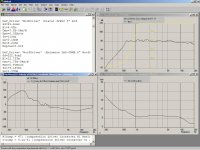
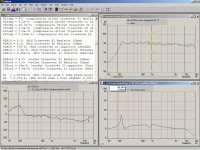
 As an owner of an original Unity Horn I can say the effort you are putting into this will definitely be worthwhile (as you would already know). Seems I need to build another to do a comparison
As an owner of an original Unity Horn I can say the effort you are putting into this will definitely be worthwhile (as you would already know). Seems I need to build another to do a comparison 